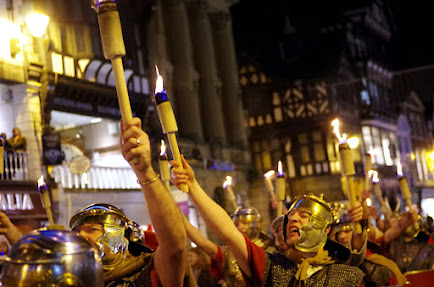Saturnalia & Yule Traditions

Saturnalia, held in mid-December, is an old Roman agnostic celebration respecting the agrarian god Saturn. As a result of when the occasion happened — close to the colder time of year solstice — Saturnalia festivities are the wellspring of a significant number of the customs we currently partner with Christmas, like wreaths, candles, devouring, and present giving.
Saturnalia, the most well known occasion on the old Roman schedule, got from more established cultivating related customs of midwinter and the colder time of year solstice, particularly the act of offering gifts or forfeits to the divine beings throughout the colder time of year planting season.
The agnostic festival of Saturn, the Roman lord of farming and time, started as a solitary day, yet by the late Republic (133-31 B.C.) it had extended to a weeklong celebration starting December 17. (On the Julian schedule, which the Romans utilized at that point, the colder time of year solstice fell on December 25.)
During Saturnalia, work and business stopped. Schools and courtrooms shut, and the typical social examples were suspended.
Individuals brightened their homes with wreaths and other vegetation, and shed their conventional frocks for brilliant garments known as blend. Indeed, even subjugated individuals didn't need to work during Saturnalia, however were permitted to partake in the merriments; at times, they found a spot at the top of the table while their lords served them.
Rather than working, Romans spent Saturnalia betting, singing, playing music, devouring, mingling and giving each other gifts. Wax tighten candles called cerei were normal gifts during Saturnalia, to mean light returning after the solstice.
On the last day of Saturnalia festivities, known as the Sigillaria, numerous Romans gave their companions and friends and family little earthenware puppets known as signillaria, which might have alluded back to more seasoned festivals including human penance.
Saturnalia was by a wide margin the jolliest Roman occasion; the Roman writer Catullus broadly depicted it as "the most ideal situation." So wild were the merriments that the Roman writer Pliny supposedly fabricated a soundproof room so he could work during the boisterous festivals.
Built in the fourth century A.D. to supplant a previous sanctuary, the Sanctuary of Saturn in Rome filled in as the stately focus of later Saturnalia festivities. On the main day of the celebrations, a youthful pig would frequently be openly forfeited at the sanctuary, which was situated in the northwest corner of the Roman Discussion.
The faction sculpture of Saturn in the sanctuary customarily had woolen bonds tied around his feet, yet during Saturnalia these bonds were slackened to represent the god's freedom.
In numerous Roman families, a fake ruler was picked: the Saturnalicius princeps, or "head of Saturnalia," once in a while likewise called the "Master of Mismanagement." Normally a lowlier individual from the family, this figure was answerable for making underhandedness during the festivals — offending visitors, wearing insane dress, pursuing ladies and young ladies, and so on.
The thought was that he governed over bedlam, as opposed to the typical Roman request. The normal occasion custom of concealing coins or other little items in cakes is one of many tracing all the way back to Saturnalia, as this was a strategy for picking the false ruler.
Because of the Roman Realm's victories in England and the remainder of Europe from the second century B.C. to the fourth century A.D. — and their concealment of more established occasional rituals rehearsed by the Celts and different gatherings — the present Western societies determine a large number of their conventional festivals of midwinter from Saturnalia.
The Christian occasion of Christmas, particularly, owes a large number of its customs to the old Roman celebration, including the season Christmas is praised. The Good book doesn't give a date for Jesus' introduction to the world; as a matter of fact, a few scholars have finished up he was presumably brought into the world in spring, as proposed by references to shepherds and sheep in the Nativity story.
Yet, by the fourth century A.D., Western Christian chapels chose observing Christmas on December 25, which permitted them to integrate the occasion with Saturnalia and other well known agnostic midwinter customs.
Agnostics and Christians coincided (however not in every case joyfully) during this period, and this probably addressed a work to persuade the leftover agnostic Romans to acknowledge Christianity as Rome's true religion.
Prior to the furthest limit of the fourth 100 years, a significant number of the customs of Saturnalia — including giving presents, singing, lighting candles, devouring and fun — had become consumed by the practices of Christmas as a considerable lot of us know them today.



Comments
Post a Comment